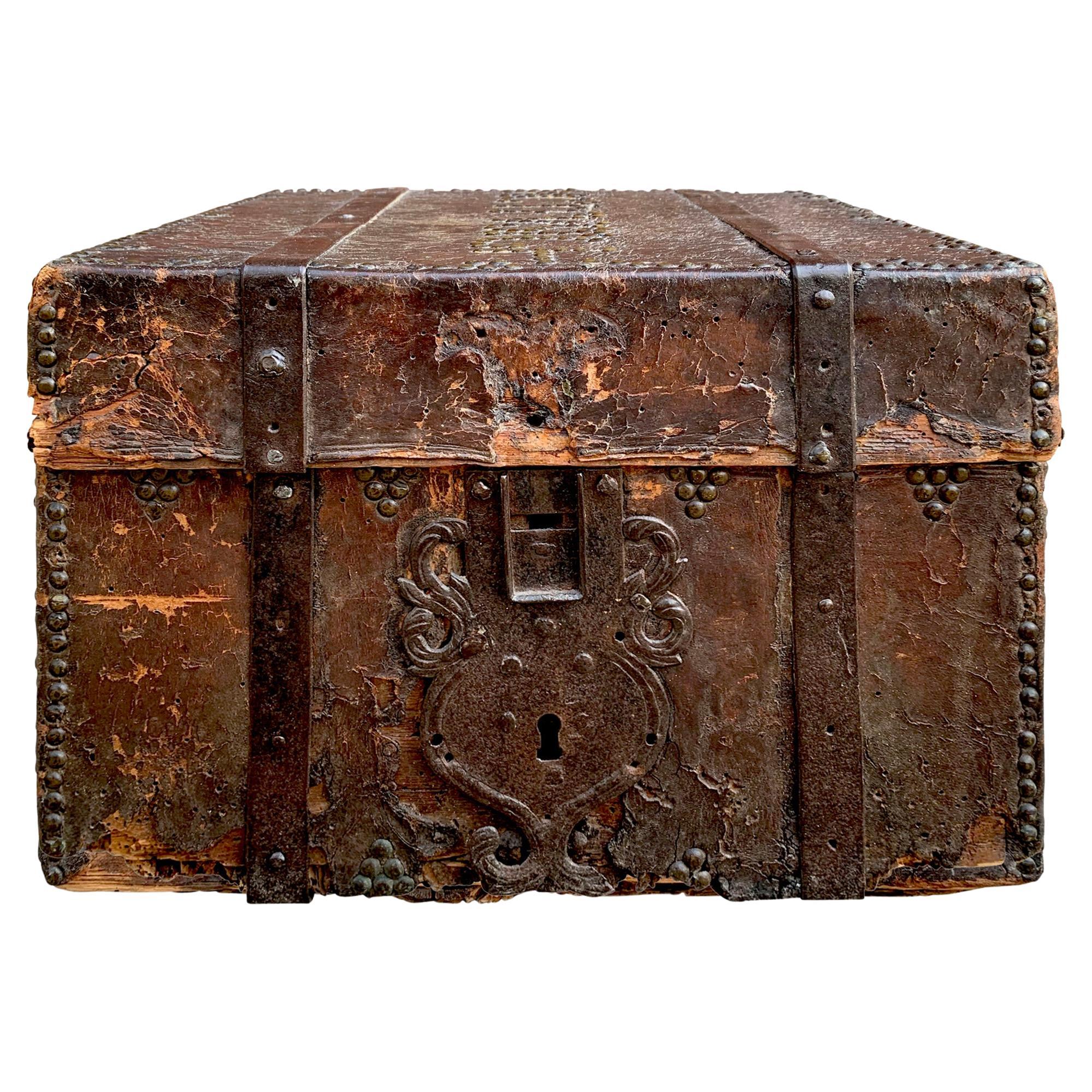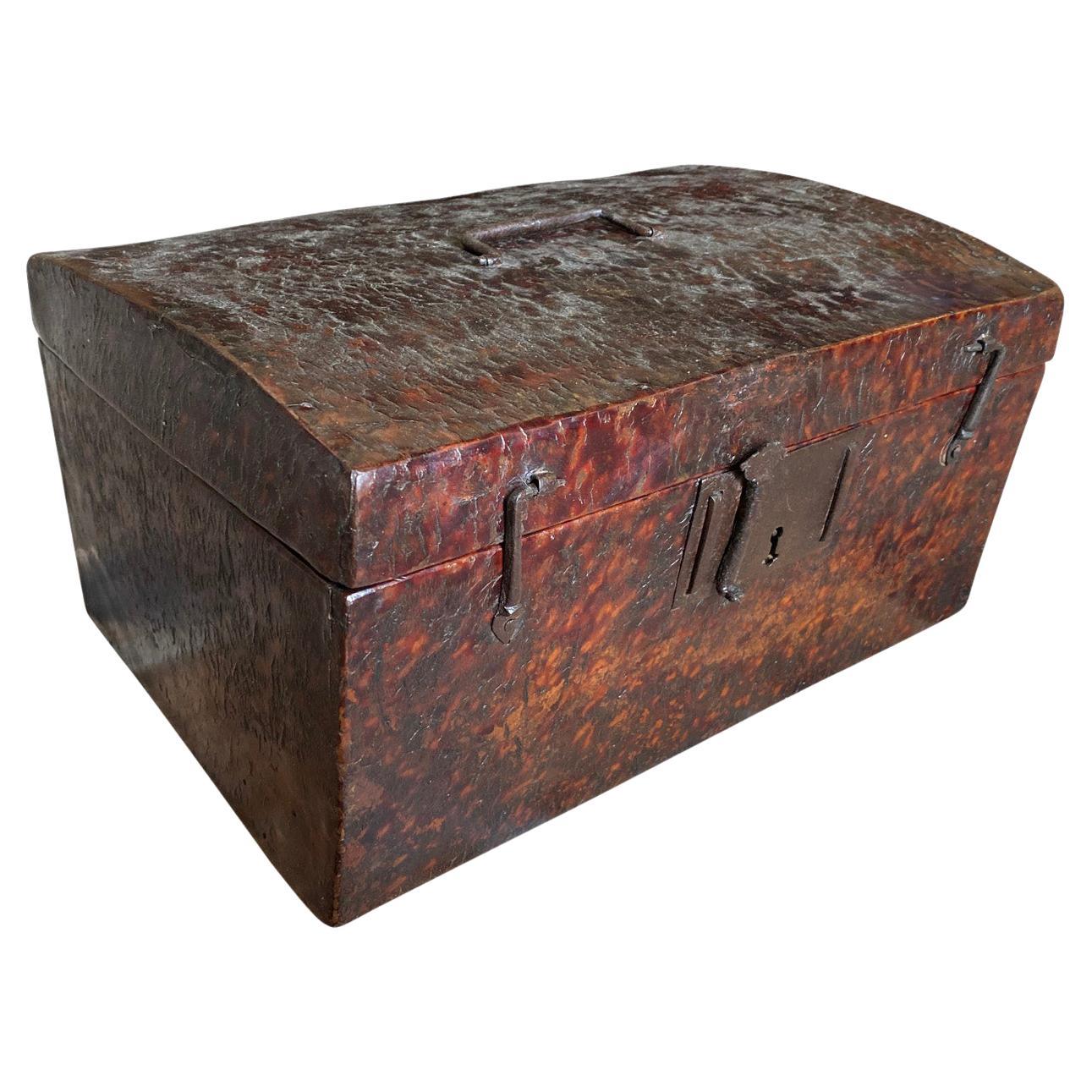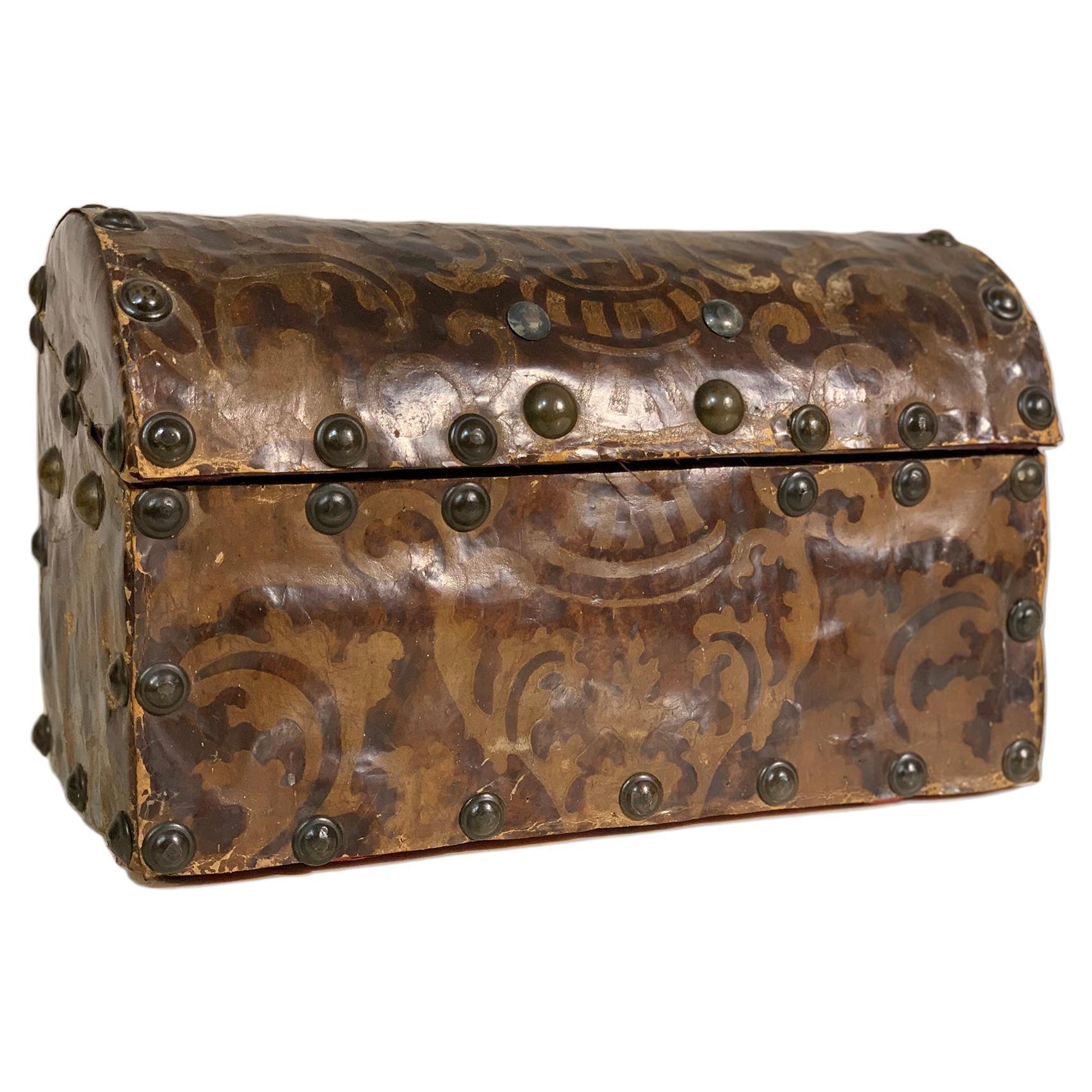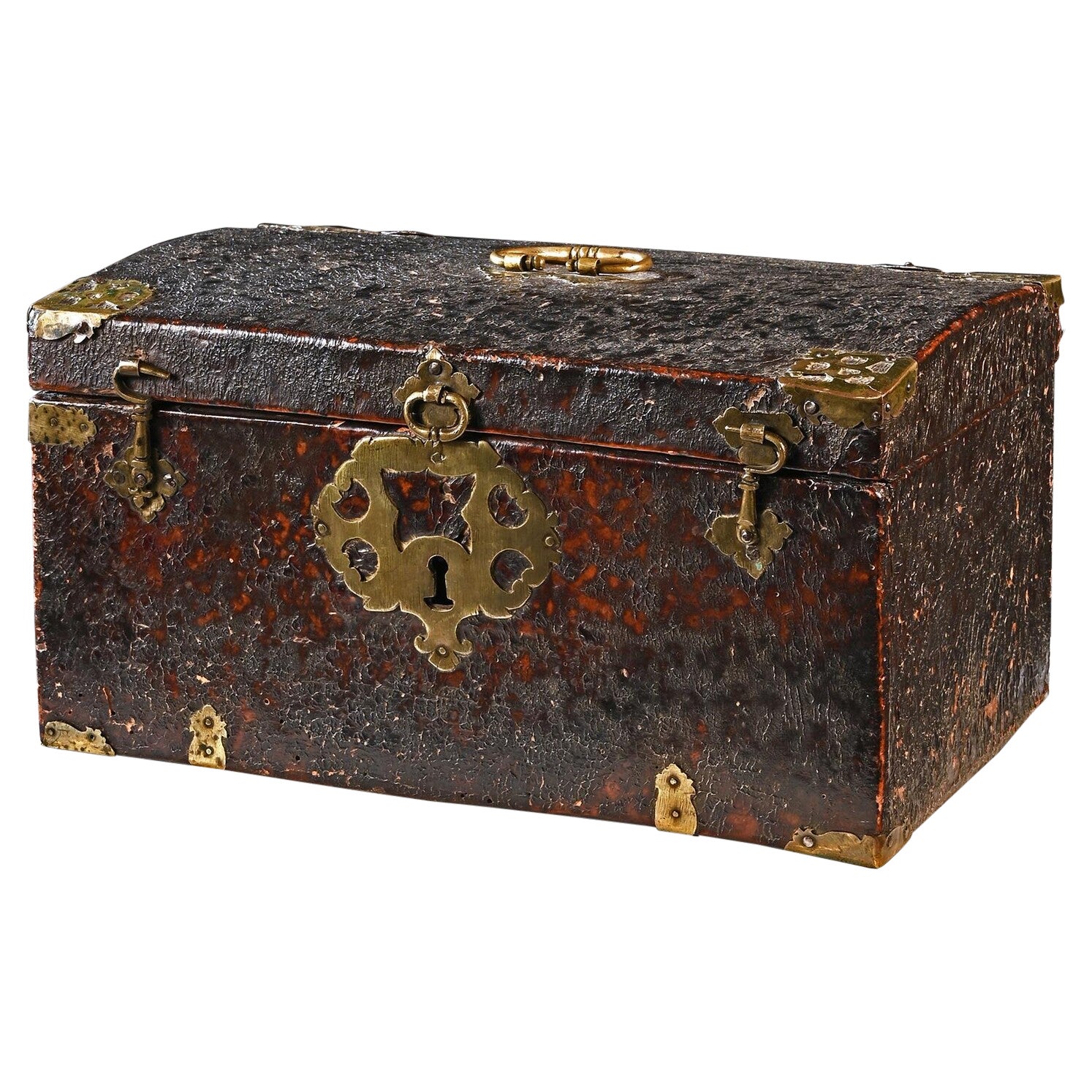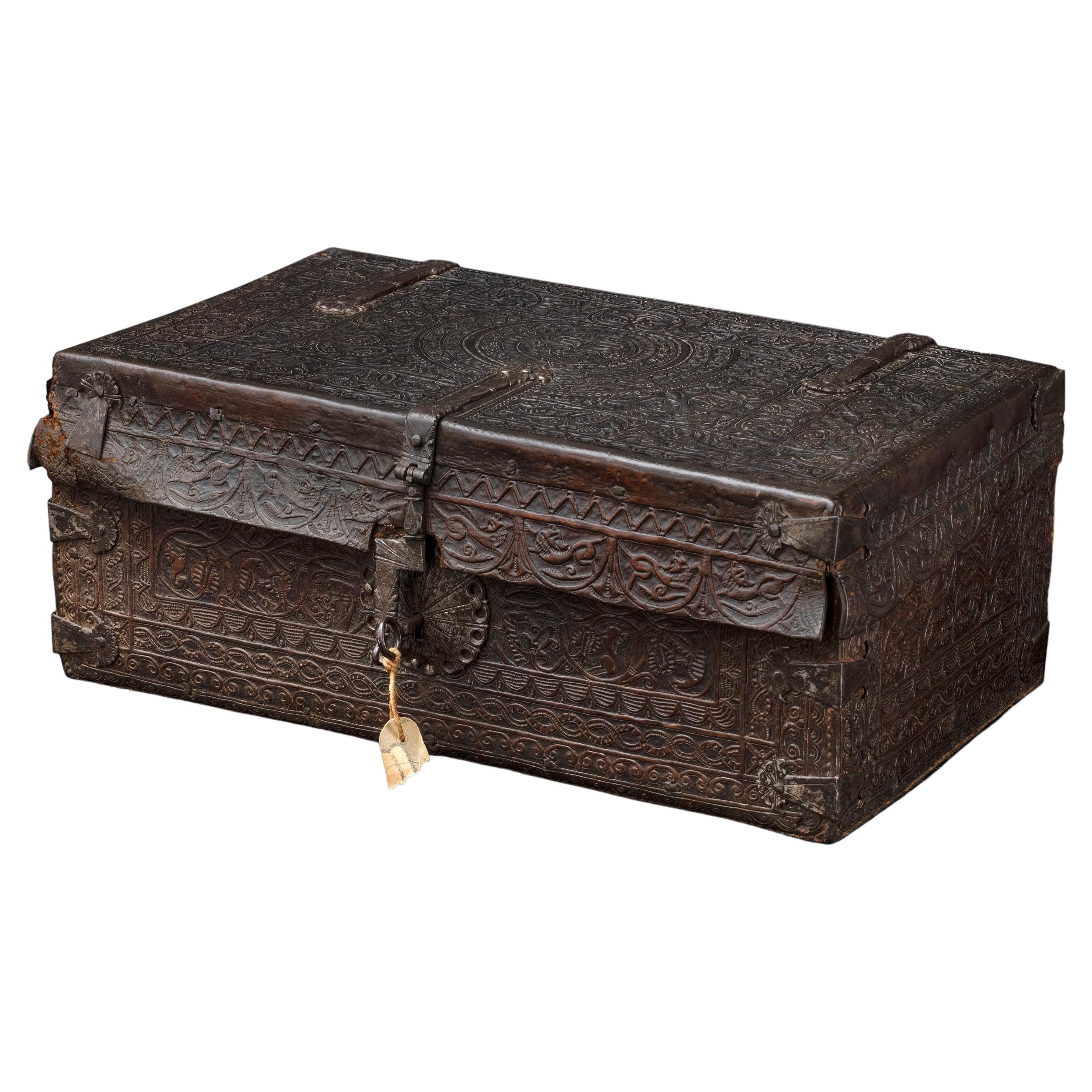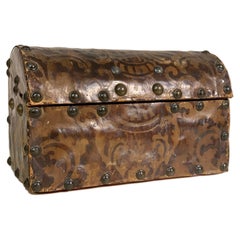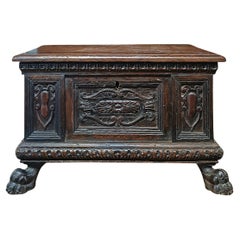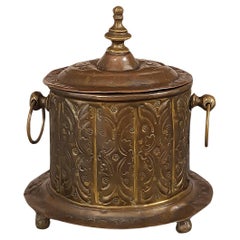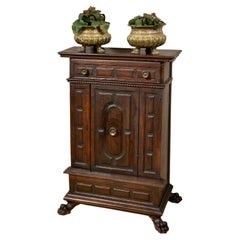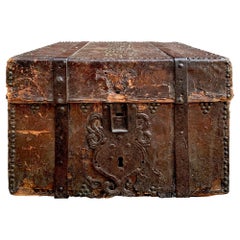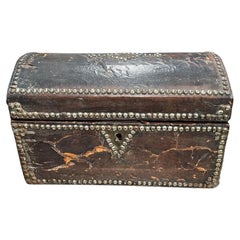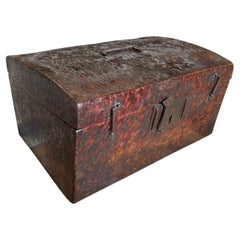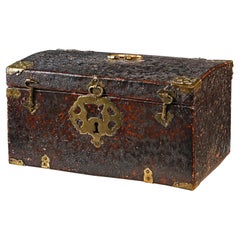Items Similar to 17th CENTURY LEATHER CANDLE CASE
Want more images or videos?
Request additional images or videos from the seller
1 of 11
17th CENTURY LEATHER CANDLE CASE
$1,984.84
£1,487.76
€1,680
CA$2,726.83
A$3,044.25
CHF 1,595.14
MX$37,264.64
NOK 20,258.33
SEK 19,101.03
DKK 12,788.77
Shipping
Retrieving quote...The 1stDibs Promise:
Authenticity Guarantee,
Money-Back Guarantee,
24-Hour Cancellation
About the Item
Particular little wooden candle holder case covered in fire-branded leather, with bronze hinges. The cassina features floral and gemometric decorations that create boxes within which zoomorphic images are depicted such as two intertwining peacocks (on the front and back), a snake and an eagle (on the sides of the object). There are slight defects and wear at the foot of the Cassina. The object can be ascribed to Venetian manufacture, whose decorations are typical of the 17th century.
Measurements: HxWxD 36.5 x 45 x 23.5cm
- Dimensions:Height: 14.38 in (36.5 cm)Width: 17.72 in (45 cm)Depth: 9.26 in (23.5 cm)
- Materials and Techniques:
- Place of Origin:
- Period:Late 17th Century
- Date of Manufacture:1680
- Condition:Minor losses. Minor structural damages. We remind you that the authorization of the Fine Arts is required for export.
- Seller Location:Firenze, IT
- Reference Number:1stDibs: LU7189236313102
About the Seller
4.0
Vetted Professional Seller
Every seller passes strict standards for authenticity and reliability
1stDibs seller since 2022
32 sales on 1stDibs
Typical response time: 1 hour
- ShippingRetrieving quote...Shipping from: Firenze, Italy
- Return Policy
Authenticity Guarantee
In the unlikely event there’s an issue with an item’s authenticity, contact us within 1 year for a full refund. DetailsMoney-Back Guarantee
If your item is not as described, is damaged in transit, or does not arrive, contact us within 7 days for a full refund. Details24-Hour Cancellation
You have a 24-hour grace period in which to reconsider your purchase, with no questions asked.Vetted Professional Sellers
Our world-class sellers must adhere to strict standards for service and quality, maintaining the integrity of our listings.Price-Match Guarantee
If you find that a seller listed the same item for a lower price elsewhere, we’ll match it.Trusted Global Delivery
Our best-in-class carrier network provides specialized shipping options worldwide, including custom delivery.More From This Seller
View All17th Century, Italian Wooden Box Coated in Engraved Leather
Located in Firenze, FI
Wooden box lined with leather engraved with damask motifs, studded with convex bronze nails. This casket was used by placing it on the altars of the family chapels to house the candl...
Category
Antique Late 17th Century Italian Decorative Boxes
Materials
Leather, Wood
LATE 16th CENTURY SMALL WALNUT BOX
Located in Firenze, FI
Elegant solid walnut small box, entirely hand-carved. The rectangular chest features an opening top, ideal for storing objects. The front, back, and sides are decorated with geometri...
Category
Antique 16th Century Italian Renaissance Decorative Boxes
Materials
Nutwood
FIRST HALF 17th CENTURY BRASS ESSENCE HOLDER
Located in Firenze, FI
Splendid hand-embossed brass essence holder with turned ends. The lid can be opened to insert essences, while the body is decorated with embossed plant motifs, giving the object a re...
Category
Antique 17th Century Italian Garniture
Materials
Brass
17th Century Candle Holder Sideboard
Located in Firenze, FI
Nice sideboard in solid walnut with ashlar paneling with geometric patterns and dark patina. It has a door in the central part with a small drawer under the top. The base is refined ...
Category
Antique 17th Century Italian Louis XIV Sideboards
Materials
Walnut
18th CENTURY SMALL PAINTED TRAVELING CHEST
Located in Firenze, FI
Small poplar wood traveling chest (placed at the back of carriages) painted with tempera in shades of blue, white, and red. The painting, which extends across the entire surface of t...
Category
Antique Early 18th Century Italian Cabinets
Materials
Wrought Iron
19th CENTURY AGATE JEWELLERY BOX
Located in Firenze, FI
Beautiful jewelry box made of agate with golden brass finishes, small in size. The turned feet are also made of agate, giving the piece a particular elegance. The hard stone, due to ...
Category
Antique Late 19th Century Italian Jewelry Boxes
Materials
Agate, Brass
You May Also Like
17th Century Italian Leather Box
Located in Chicago, IL
A stunning 17th century Italian leather covered wood trunk covered in brass nail heads, some spelling out a word on top, and with iron strap hinges a...
Category
Antique 17th Century Italian Baroque Decorative Boxes
Materials
Leather, Wood
$1,050 Sale Price
25% Off
18th Century Antique Leather Box with Nailheads
Located in New Orleans, LA
This antique leather box with nailheads is not only a beautiful decorative item but also a functional piece of history. It could have been used for a variety of purposes, such as sto...
Category
Antique 18th Century French Decorative Boxes
Materials
Brass
French 17th Century Leather Box, Coffre
Located in Round Top, TX
A very charming late 17th century French Coffre - Box crafted from beautifully patina'd leather. A wonderful piece to serve as a jewelry box or to adorn any table top.
Category
Antique 17th Century French Decorative Boxes
Materials
Leather
Late 17th Century Leather And Brass Travelling Box
Located in Benington, Herts
A very fine and interesting late 17th century English work box or travelling case
English Circa 1680
Of conventional form with slightly domed lid, this piece has acquired a magnifi...
Category
Antique 1680s English Decorative Boxes
Materials
Brass
Boiled Leather Trunk, Spanish, 17th Century
Located in Bruxelles, BE
Leather trunk
Spanish, 17th century
Boiled Leather, wood and iron
Measures: 22 x 53 x 32 cm.
Provenance :
- collection Metz-Noblat, Château de Clevant, France
Rectangular trunk of the form and size of a small suitcase with wrought iron hinges and lock-plate.
Wood, covered with leather, cut and embossed with every surface of the thick cow hide covered in interlace, zoomorphic features.
The construction method is boiled leather, often referred to by its French translation cuir-bouilli: a process used to change flexible, vegetable-tanned leather into rigid, moulded objects. For shaping of the vegetable-tanned leather, heat and moisture were used, as indicated by the term boiled leather. No written medieval sources describing the production of decorated cuir bouilli objects survive, so knowledge of the process relies on the important studies of the Scottish leather historian John William Waterer. A large range of methods, materials and techniques could be used in various combinations. The vegetable-tanned leather, made supple with moisture and heat, was stuffed, shaped and nailed to the rigid wooden coffer support. The stuffing material was probably modeled beeswax or stearin wax. To shape the leather, to create its topography, « Cushions » were made by lacing a thread through an awl hole and attaching the flexible leather and stuffing to the rigid wooden support on the bottom. Then the decoration was done: lines were incised through the upper layer of the leather (epidermis) with different thicknesses of knives or needles. Contours were created with deep v-shaped cuts, decoration with thin incision and final details with a needle point. For the incision and pouncing stage, the leather was probably kept heated and moistened for suppleness.
Once dry, the leather would be hard and rigid.
the saturated leather is worked over a form, possibly even damp sand, with the pattern shaped using bone or wooden tools. Compare to metal, leather was lighter and it offered protection from cuts and punctures. Cuir bouilli objects were produced by specialist leather workers and needed skillful craftsmanship.
The surface is filled with roundels shaped foliages enclosing animals, lions and peacocks. The foliate arabesques creating a vegetal connection tweet the animals create the impression of a lush verdant space . The vegetal pattern here employed in combination with geometrical pattern came from the pre-islamic artistic traditions of the Byzantine and Sasanian empires. An aspect of Islamic geometry Is the basic symmetrical repetition and mirroring of the shapes that create a sense of harmony.
The decoration of this truck is inspired by the islamic « arabesque » a form of vegetal ornament composed of spirals, intertwining plants and abstract curvilinear motifs. An arabesque character is given to the birds of the decorations through extreme stylisation. This arabesque maintained the classical tradition of median symmetry, freedom in Detail and heterogeneity of ornament.
The presence of the peacocks is a paradisiacal allusion: in popular Islamic literature they were among the original inhabitants of the garden of Paradise expelled with Adam and Eve. Peacock as a decorative motif may have originated in the West, despite their eastern provenance. There was an ancient belief that the flesh and feathers of peacock do not decay. This led to the peacock becoming a christian symbol for Christ’s resurrection.
Renowned for their decorative wall hangings, seventeenth-century Spanish leatherworkers also produced utilitarian objects, such as this trunk. A similar trunk is on display at the Metropolitan museum of art ( 09.158.1).
Related literature :
Davies L. 2006. Cuir bouilli. Conservation of leather and related materials, 94-102, Oxford: elsevier Butterworth-Heinemann
Grabar, Oleg. The Mediation of Ornament. Princeton: Princeton University Press, 1992
Gabriela Germana Roquez, "El mueble en el Peru en el siglo XVIII...
Category
Antique 17th Century Decorative Boxes
Materials
Iron
Small 17th Century, French Coffer or Box in Leather
Located in Buisson, FR
Extremely old box that is covered with leather and metal decorations.
Rare find.
France, circa 1600-1700
Weathered and some losses.
Category
Antique 17th Century French Decorative Boxes
Materials
Leather, Wood
$939 Sale Price
49% Off
More Ways To Browse
Leather Items
17th Century Venetian
Eagle Candle
Religious Statues
Gothic Church Items
Ex Voto
Antique Baby Items
Antique Catholic Crosses
Hand Reliquary
Used Synagogue Furniture
Antique Torah
Brutalist Cross
Antique Family Bible
Used Catholic Church Items
Head Of Jesus
Gothic Trefoil
Religious Reliquary
Rare Antique Bibles
